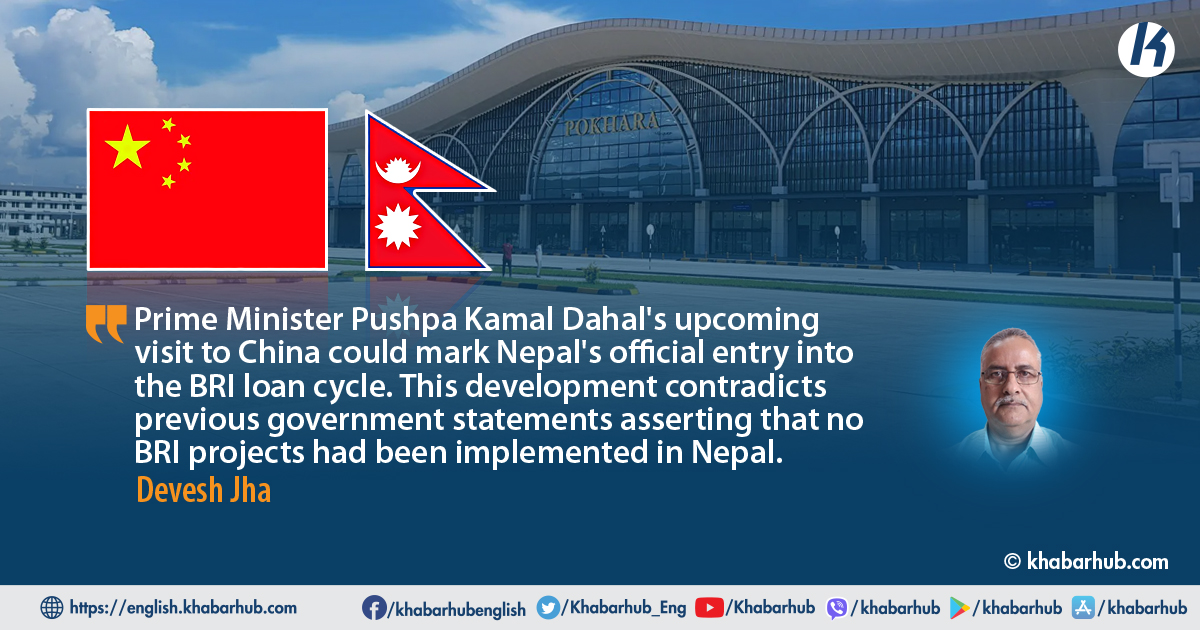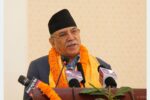Prime Minister Pushpa Kamal Dahal ‘Prachanda’ is scheduled to visit China during the last week of September.
Amidst ongoing uncertainty regarding the status of the Belt and Road Initiative (BRI) implementation in Nepal, recent information suggests that preliminary work has commenced towards finalizing a BRI ‘Project Implementation Plan’ agreement during the Prime Minister’s upcoming visit to China.
According to sources within the Ministry of Foreign Affairs, nearly six years after the initial signing of the BRI agreement, Nepal is on the verge of signing the crucial ‘Project Implementation Plan’ agreement.
This agreement will pave the way for the selection and execution of projects falling under the BRI umbrella.
Back in May 2017, Nepal and China inked a partnership agreement under the BRI, an initiative designed to facilitate global connectivity through Chinese investments.
During the visit of then-Prime Minister KP Sharma Oli to China in 2019, Nepal initially presented a list of 35 projects for inclusion in the BRI. This list was subsequently trimmed down to 9 projects at China’s request.
These projects encompass a range of endeavors, including the upgrade of the Rasuwagadhi-Kathmandu road, construction of the Kimathanka road, the Dipayal-Chinese border road, the Tokha-Bidur road (featuring a tunnel), the Galchi-Rasuwagadhi-Kerung 400 KV transmission line, the feasibility study for the Kerung-Kathmandu railway, the Tamor Hydro Project (762 KV), the Phukot Karnali Hydro Project (426 KV), and the Madan Bhandari University.
Several of these projects are already in various stages of implementation. During his visit to Nepal in March 2022, Chinese Foreign Minister Wang Yi proposed signing the agreement.
Information received suggests that Nepal might need to accept China’s proposed interest rate for the BRI, possibly with modifications to the rate and repayment period, to manage and maintain Pokhara Airport, which was constructed under the BRI initiative.
However, the government led by Sher Bahadur Deuba at the time declined to do so, arguing that Nepal would only accept grants and concessional loans under the BRI, not commercial loans.
Despite the existence of a BRI agreement between Nepal and China, confusion persists due to the lack of consensus on the project implementation plan. According to the Chinese perspective, BRI projects are already underway in Nepal.
On June 23 this year, Chinese Ambassador Chen Song asserted that Pokhara Airport falls under the BRI project.
Earlier, during the airport’s opening ceremony in January 2023, China’s Acting Ambassador Wang Xin also stated that the airport had been constructed as part of the BRI initiative.
However, the Nepali side continues to assert that no formal agreement has been reached on any project under the Belt and Road Initiative (BRI).
Foreign Minister NP Saud, addressing the Parliament, reiterated that no BRI projects have been implemented in Nepal.
The ongoing discussions between Nepal and China center solely on the project implementation plan, underscoring the absence of a concrete program.
It appears that the Ministry of Foreign Affairs is actively working to refute the contentious claim regarding the construction of Pokhara Airport being part of the BRI project.
This effort may be geared toward reestablishing legal clarity by formalizing the agreement during the Prime Minister’s forthcoming visit to China.
For China, the Belt and Road Initiative (BRI) represents more than just a typical development project; it’s a meticulously orchestrated endeavor aimed at reshaping the global political and economic landscape.
Information received suggests that Nepal might need to accept China’s proposed interest rate for the BRI, possibly with modifications to the rate and repayment period, to manage and maintain Pokhara Airport, which was constructed under the BRI initiative.
Prime Minister Prachanda’s upcoming visit to China is likely to mark Nepal’s official entry into the BRI loan cycle.
This development contradicts previous government statements asserting that no BRI projects had been implemented in Nepal.
The desire on both sides to resolve the dispute over the successful landing of an international flight in Pokhara under the BRI project appears to be a priority.
Whether by coincidence or design, a high-level political delegation from the main opposition party, led by CPN-UML General Secretary Shankar Pokharel, is currently visiting China just ahead of the Prime Minister’s visit.
This 12-day visit, intended to discuss bilateral relations and cooperation between the UML and the Chinese Communist Party, has been scheduled strategically.
The 22-member UML team includes MPs responsible for foreign affairs, women’s issues, publicity, and other departments, as well as representatives from trade and student unions.
Through the BRI, China seems to implement a strategy of gaining control over the resources and markets of participating nations, effectively making them ‘economic dependents.’
This visit assumes political significance, particularly in the context of the growing interest in left unity. It’s worth noting that the CPN was initially formed through the merger of the UML and the Maoists, with indirect support from China.
During that time, despite the global challenges posed by the COVID-19 pandemic, the Chinese Communist Party conducted training programs for the CPN via video conferencing.
However, the process was disrupted following the split of the CPN and the formation of the Congress-Maoist alliance, which remains a complex situation. Consequently, the ambitious Belt and Road Initiative (BRI) project faces hurdles in its implementation in Nepal.
For China, the Belt and Road Initiative (BRI) represents more than just a typical development project; it’s a meticulously orchestrated endeavor aimed at reshaping the global political and economic landscape.
China’s ambition to ascend as a world superpower has come at a substantial cost, particularly for developing nations.
It appears that China is employing debt trap tactics to secure a foothold in world markets, foment unrest in non-compliant countries, and infringe upon human rights while expanding its territorial influence.
In essence, the BRI is a vehicle through which China seeks to exert immense influence on the global stage, often at the expense of economic and political sovereignty for the nations it engages with.
Through the BRI, China seems to implement a strategy of gaining control over the resources and markets of participating nations, effectively making them ‘economic dependents.’
Consider the fear that silenced many nations when it came to questioning the origins of the Wuhan Coronavirus or the limited voices raised by Muslim-majority countries regarding the Chinese government’s treatment of Uyghur Muslims.
Recent research conducted by an international organization reveals that around 100 agreements have been inked with 24 countries under the BRI.
These agreements often involve significant loans at low-interest rates from China that are challenging to repay.
Subsequently, China gradually seizes control of these nations’ resources, markets, infrastructure, and strategic locations, particularly if they do not align with China’s opportunistic, expansionist, and deceptive ideology. Several examples illustrate this pattern:
Tajikistan: In this debt-burdened nation, China has annexed an area spanning 1,158 square kilometers, exploiting natural resources such as minerals, gold, and silver.
Laos: Chinese companies have gained control over Laos’ national grid through a 25-year deal in exchange for loans.
Montenegro: A hefty $800 million loan from China for highway construction is virtually impossible to repay, with the highway serving as a strategic gateway to Europe.
Angola: Chinese control over crude oil reserves has further damaged the Angolan economy.
China has similarly ensnared countries in South Asia, including Sri Lanka, Nepal, Pakistan, Maldives, and Bangladesh. While Pakistan may appear as a natural ally of China, the reality is that its situation is deteriorating by the day.
This decision appears linked to the “Project Implementation Plan” agreement under the BRI during the Prime Minister’s visit to China, raising the question of whether China’s BRI and the MCC are being equated through this visit.
In essence, the BRI is a vehicle through which China seeks to exert immense influence on the global stage, often at the expense of economic and political sovereignty for the nations it engages with.
As a result of the debt trap policy, Pakistan is currently on a trajectory toward social and economic collapse.
China has gradually assumed control of vital locations, ports, and resources in the country, compelling it to comply with Chinese directives. Reports have even surfaced suggesting that certain areas within Pakistan have been designated as off-limits by China.
Sri Lanka, too, found itself ensnared in a similar debt trap, leading to the leasing of the Hambantota port, along with 15,000 acres of land, to a Chinese company for a staggering 99-year period due to unpaid debts. The Hambantota port holds significant strategic and commercial importance.
Maldives, another nation, has fallen into the clutches of the debt trap, with debt agreements teetering on the brink of collapse.
Chinese diplomacy can be distilled into the “Five D’s” – Debt, Deceit, Dominate, Demand, and Destroy.
Under the guise of the Belt and Road Initiative (BRI), China’s loan trap policy seeks to achieve benefits through three avenues: military bases in economically, politically, and strategically significant locations.
Notably, Nepal’s current foreign policy, based on non-alignment and the Panchsheel principles, underscores the notion of treating all nations equally without favoritism. Therefore, even if only loans are provided, China expects equal treatment.
Similarly, the concept of “equidistant” was introduced in foreign policy during the cooperation between the then-CPN and the Chinese Communist Party (CPC), formed after the merger of the UML and Maoists.
“Equality” signifies equal treatment of lenders and grantees, meaning that U.S. grant aid through the Millennium Challenge Corporation (MCC) and loans from China should be treated equally when it comes to the Belt and Road Initiative (BRI).
The weight of debt incurred through the Belt and Road Initiative (BRI) and the benefits of grants from the Millennium Challenge Corporation (MCC) cannot and should not be considered equivalent.
The introduction of the term “equidistance” in foreign policy was likely influenced by the unfriendly behavior of the previous government toward India.
While China is undoubtedly a friendly neighboring country, achieving the same level of ease as with India raises questions.
Months ago, Nepali residents were granted access to Khasa Bazar in Tibet, with entry passes restricted to those within 30 kilometers of the border in Sindhupalchok.
Such behavior raises questions about whether similar gestures occur at the Raxaul, Jogbani, or Kakadvitta borders.
This decision appears linked to the “Project Implementation Plan” agreement under the BRI during the Prime Minister’s visit to China, raising the question of whether China’s BRI and the MCC are being equated through this visit.
Treating loans and grants equally may have unintended consequences. Despite commitments, statistics show that Nepal received only one billion dollars in foreign investment within a year.
Nepal’s “equidistance” policy, which equates grants and loans, does not seem to facilitate assistance. Notably, a recently released map from China depicts Nepal’s Lipulekh and Limpiyadhura as part of India. It appears that whoever treats all equally may find themselves without any special priority.
The weight of debt incurred through the Belt and Road Initiative (BRI) and the benefits of grants from the Millennium Challenge Corporation (MCC) cannot and should not be considered equivalent.
While we wish for Prime Minister Prachanda’s visit to China to be fruitful, it is crucial that we do not saddle future generations with undue debt in the name of equality.








Comment